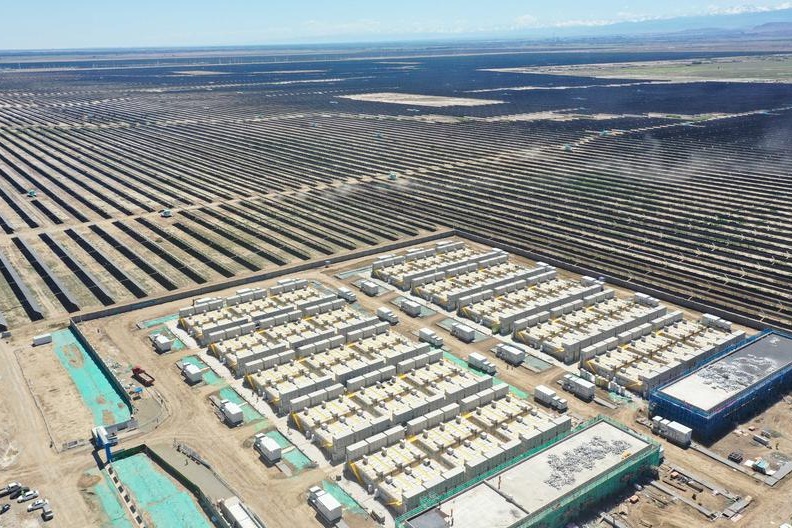Nonfossil sources to play big role in use of energy

Driven by rapid growth in wind, solar, hydro and nuclear power, nonfossil energy sources are projected to account for approximately 35 percent of China's total energy consumption by 2035, and rise to around 80 percent by 2060, according to a new industry report.
The "China Energy Outlook 2025-2060" report, released by China Energy Investment Corp (CHN Energy) on Monday, forecasts a continued green and low-carbon transition in China's energy mix, shifting away from the current coal-dominated era toward a more diversified landscape.
CHN Energy is the country's largest coal-fired power generator by capacity.
China's energy-related carbon emissions are expected to peak before 2030, within a range of 11.4-11.6 billion metric tons, said Sun Baodong, chairman of CHN Energy Technology and Economics Research Institute.
Emissions are expected to decline steadily during the 16th Five-Year Plan period (2031-35), with relatively low carbon emissions per unit of GDP, a projected reduction of over 45 percent by 2035 compared to 2020 levels, he said.
Sun also emphasized the importance of energy security for China's modernization, advocating for a gradual increase in the country's energy self-sufficiency rate.
The report projects that China's primary energy self-sufficiency rate will steadily increase from the current level of around 80 percent, exceeding 90 percent by around 2045, achieving a high degree of energy independence.
Nonfossil energy sources are expected to play an increasingly critical role in ensuring energy supply security, becoming the primary driver of energy growth in the near and medium term, and ultimately replacing fossil fuels in the long term, it said.
Industry experts believe while the transition to renewables is crucial for decarbonization, the focus on energy security also highlights the importance of maintaining a stable and reliable energy supply.
"China's approach balances environmental goals with the need to ensure uninterrupted economic growth," said Lin Boqiang, head of the China Institute for Studies in Energy Policy at Xiamen University.
"This ambition reflects a long-term strategic vision to secure its energy future and reduce reliance on foreign suppliers," he said.
"Amid global energy market fluctuations, diversifying the energy mix and prioritizing domestic production are key strategies to mitigate these risks."
According to the report, overall energy consumption is expected to grow steadily over the next decade, reaching 7.1-7.2 billion tons of standard coal equivalent around 2035, representing a roughly 20 percent increase from current levels.
While oil consumption has currently plateaued at 730-750 million tons, the report projects a decline to around 700 million tons by 2030, driven by the increasing adoption of electric vehicles and a gradual saturation of the petrochemical industry.
Natural gas is expected to play a transitional role in the energy system's transformation and the achievement of China's "dual-carbon" goals, with significant growth potential. Consumption is projected to peak at 590-600 billion cubic meters by around 2035, it said.
Electricity demand is forecast to maintain long-term growth, fueled by economic and social development and the increasing electrification of end-use sectors.
The report estimates overall electricity consumption average annual growth rates of approximately 4.5 percent and 2.9 percent during the 15th Five-Year Plan period (2026-30) and 16th Five-Year Plan period, respectively, reaching 13.3 trillion kWh by 2030 and 15.3 trillion kWh by 2035.
Overall electricity consumption is expected to peak between 2050 and 2060, within a range of 17.8-18.1 trillion kWh, it said.
Coal consumption is expected to remain high in the short term, driven by demand from the power generation and chemical industries, peaking at 4.95-5.1 billion tons during the early to mid-15th Five-Year Plan period, it said.
Consumption of coal is projected to remain above 4.6 billion tons by 2035. After peaking, domestic coal production capacity is expected to gradually contract as older mines are retired. However, the report anticipates that overall coal supply and demand will remain largely balanced over the next two decades.
Today's Top News
- Auto market rides high on NEV sales growth
- China, Spain agree to advance partnership
- Xi hails governance exchanges between CPC, CPV
- EU betraying its proclaimed principles: China Daily editorial
- Visit highlights resilient, dynamic and forward-looking China-Spain partnership
- WIPO: China retains its position as the global leader with 1.8 million patent applications






























